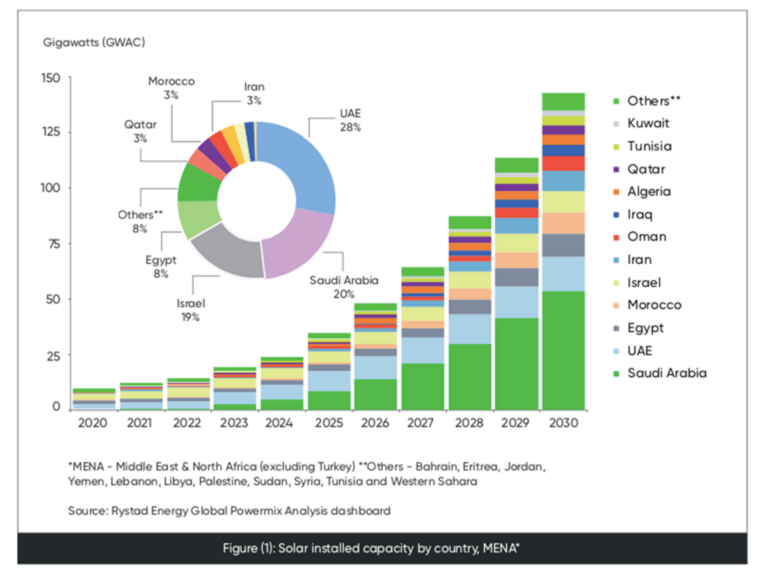According to the latest report from the Middle East Solar Industry Association (MESIA), solar capacity in the Middle East and North Africa (MENA) region will grow by 25% by 2024, with local production and energy storage also accelerating.
There was significant growth in the MENA solar energy market in the region by 2024, according to the latest report from MESIA.
The association “Solar Outlook Report 2025” provides an overview of the trends, innovations, technical advances, challenges and opportunities of the region’s solar landscape. MENA’s solar capacity is forecast to reach 24 GW (AC) by 2024, which would represent a 25% increase year-on-year.
According to the report, more than 80% of this growth was concentrated in Saudi Arabia, the United Arab Emirates and Egypt. It added that Morocco continues to lead the North African market as it has now surpassed 2 GW of total solar capacity, followed by Egypt, while Tunisia and Algeria are quickly catching up.
MESIA also noted that demand for energy storage is growing rapidly in the MENA region. That’s what it said Saudi Arabia, Morocco, Israel, Egypt, Jordan, Oman and the UAE are major players in the development of battery energy storage facilities, with more than 20 GWh of projects announced.
MESIA president Fazle Moyeen Quazi said technologies such as next-generation solar panels, energy storage systems and green hydrogen are driving the efficiency and resilience of solar projects.
“As these technologies mature, they open new avenues for the region to achieve its renewable energy goals while addressing critical issues such as intermittent energy and grid stability,” he wrote.
The report also focuses on a notable increase in the production of solar energy components. MESIA said solar panel production in the MENA region was likely to exceed 3 GW by the end of 2024, driven by production facilities in Iran, Saudi Arabia, Jordan, the UAE, Egypt and Algeria.
MESIA said the shift to local manufacturing will not only reduce the region’s dependence on imports, create jobs and encourage technological innovation, but also help it become a major player in the global solar supply chain, reinforced by its proximity to European and sub-Saharan countries. African markets.
“The region’s continued efforts to localize solar energy production and reduce dependence on third-party suppliers are crucial to the long-term success of MENA’s renewable energy strategy,” the report said. “As countries such as Morocco, Egypt and Tunisia continue to expand their solar energy capacity, MENA is not only meeting energy needs but also contributing to the global clean energy transition.”
The report highlights a number of challenges facing the region, including aligning policies, addressing supply chain disruptions and investing in capacity-building initiatives such as network infrastructure. Quazi said these challenges will “require a synergistic effort” from developers, industry leaders and governments.
“As the energy transition accelerates, collaboration will be key to unlocking the full potential of solar energy in the region,” he added.
Quazi also highlighted the role of private sector investment as a key focus for the future.
“The region has seen an increase in public-private partnerships, competitive solar procurement and innovative financing transactions that are accelerating the pace of renewable energy adoption,” he wrote. “With the global drive for net-zero emissions, international cooperation and capital flow to the MENA, the solar energy sector is expected to expand and create more opportunities for local and international players.”
This content is copyrighted and may not be reused. If you would like to collaborate with us and reuse some of our content, please contact: editors@pv-magazine.com.


